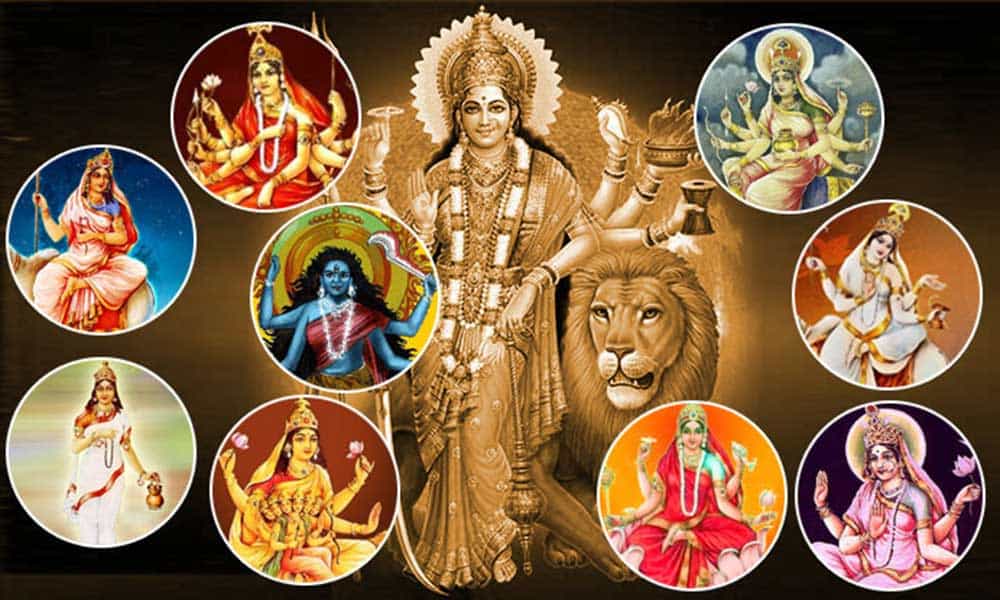The Story of 9 Avatars of Maa Durga During Navratri

During Navratri, the nine forms of Maa Durga are worshipped over nine days, each representing a distinct aspect of the Divine Mother. These forms are known as the Navadurga and each day is dedicated to one of these avatars. Each form of Maa Durga symbolizes a unique power, blessing devotees with specific qualities and strengths. Here is the story of the nine avatars of Maa Durga, celebrated during Navratri:
1. Shailaputri (Daughter of the Mountain) – Day 1
- Story: Shailaputri is the first form of Durga and is also known as Parvati, the daughter of King Himalaya (the king of the mountains). After the self-immolation in her previous incarnation as Sati, she was reborn as Shailaputri. She is depicted riding a bull (Nandi) with a trident in one hand and a lotus in the other.
- Symbolism: Shailaputri represents strength and the power of Brahma, Vishnu, and Shiva.
- Blessing: She blesses devotees with spiritual awakening, purity, and devotion.
2. Brahmacharini (The Ascetic) – Day 2
- Story: Brahmacharini is the goddess of penance and meditation. She symbolizes Parvati in her unmarried form, where she undergoes severe penance to attain Lord Shiva as her consort. She walks barefoot with a rosary in one hand and a kamandalu (water pot) in the other.
- Symbolism: Brahmacharini represents spiritual knowledge and bliss.
- Blessing: She grants strength, devotion, and determination to overcome hardships in life.
3. Chandraghanta (The Warrior Goddess) – Day 3
- Story: Chandraghanta is the fierce warrior form of Durga. After marrying Lord Shiva, Parvati adorns a half-moon on her forehead, resembling a bell. She is always ready for battle, riding a tiger and carrying weapons in her ten hands to protect her devotees from evil forces.
- Symbolism: She symbolizes bravery, grace, and protection.
- Blessing: Chandraghanta helps eliminate fears and brings peace and serenity.
4. Kushmanda (The Creator of the Universe) – Day 4
- Story: Kushmanda is the form of Durga who created the universe with her divine smile. She is believed to reside in the core of the Sun and is the source of all energy. She rides a lion and has eight arms, holding various divine objects.
- Symbolism: Kushmanda represents creation, vitality, and power.
- Blessing: She provides health, wealth, and strength to her devotees.
5. Skandamata (Mother of Skanda) – Day 5
- Story: Skandamata is the mother of Skanda (also known as Kartikeya), the god of war. She is depicted riding a lion and holding her son Skanda on her lap. She is a symbol of maternal love, care, and protection.
- Symbolism: Skandamata represents courage and selfless love.
- Blessing: She grants wisdom, prosperity, and salvation.
6. Katyayani (The Warrior Goddess) – Day 6
- Story: Katyayani is the fierce form of Durga born to sage Katyayana. She is considered the most violent form of Durga as she was born to annihilate the demon Mahishasura. Riding a lion, she has four hands and is often worshipped by unmarried girls for a good husband.
- Symbolism: Katyayani symbolizes courage, strength, and victory over evil.
- Blessing: She blesses her devotees with courage, love, and protection.
7. Kalaratri (The Goddess of Time and Death) – Day 7
- Story: Kalaratri is the most fearsome form of Durga, also known as the goddess of destruction. She is dark-skinned with a terrifying appearance, but she is the destroyer of all demons, negativity, and ignorance. Despite her fierce appearance, she brings calm and removes fear.
- Symbolism: Kalaratri represents the destruction of evil and darkness.
- Blessing: She removes fear, protects from harm, and grants peace and courage.
8. Mahagauri (The Goddess of Purity) – Day 8
- Story: After the destruction of evil in her Kalaratri form, Durga transformed into Mahagauri, symbolizing purity and calmness. She is depicted as a beautiful goddess in white, riding a bull. She is the representation of wisdom and peace.
- Symbolism: Mahagauri represents purity, tranquility, and virtue.
- Blessing: She purifies the soul and helps devotees achieve a peaceful and balanced life.
9. Siddhidatri (The Goddess of Supernatural Powers) – Day 9
- Story: Siddhidatri is the final form of Durga and is the goddess of accomplishments. She has supernatural healing powers and grants wisdom and knowledge to all her devotees, including the gods. She is seated on a lotus and is worshipped by all beings in the universe.
- Symbolism: Siddhidatri represents perfection, fulfillment, and wisdom.
- Blessing: She blesses devotees with success, happiness, and spiritual enlightenment.
Conclusion
the nine avatars of Maa Durga, each celebrated on a day of Navratri, represent different aspects of strength, wisdom, and protection. Through their stories and symbolism, these forms of the Divine Mother offer guidance, courage, and blessings to devotees. By worshipping these avatars, one can invoke the qualities they embody, such as purity, fearlessness, and spiritual enlightenment, leading to a more fulfilled and harmonious life. Navratri is a time to reflect on the power of the Divine Mother and to seek her grace for personal and spiritual growth.









